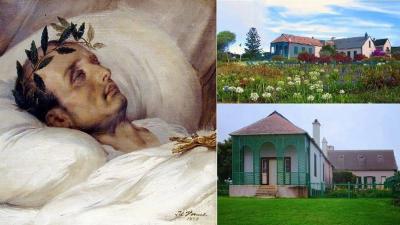At precisely 5:49 AM on Saturday, May 5, 1821, exactly two centuries ago, Napoleon Bonaparte died at the age of 51, a victim of stomach cancer, a condition that his Italian father succumbed to at the age of 38 in 1785, and shortly before him, in 1820, his sister Elisa also perished from the same illness at only 43 years old. The man who was an emperor of France and occupied the world's attention ended his life due to illness after six years of exile on an island considered one of the most isolated in the world, as reported by "Al Arabiya" in its review of the biography of Saint Helena, belonging to Britain, which is over 2000 kilometers away from any mainland.
About 35 hours after his death in bed, a "death mask" was created of Napoleon's face, currently preserved at the "Army Museum" in Paris. This practice was common at the time for prominent figures who had passed away, in preparation for sculpting statues or painting portraits of them, until cameras eventually replaced masks.
The death mask, made from a blend of plaster and wax, is said to be the most indicative of Napoleon's true features, unlike many paintings created by artists who imagined him, most of which show him with his hand on his stomach, a pose reflecting his cancer pain. However, the most revealing depiction of his face is a painting created in 1826 by French artist Horace Vernet, who specialized in battle scenes and died in 1863 at the age of 73, seemingly inspired by his observation of the death mask itself.
Looking closely at the mask, images, or the painting by Vernet, one finds that Napoleon, born on the island of Corsica (which belongs to France but is only 11 kilometers away from the Italian island of Sardinia), appearing emaciated and suffering greatly at the time of his death in the now-famous home called Longwood, due to the side effects of his malignant illness. His eyes were completely closed at the time of death, and his mouth slightly ajar, possibly from the pain that surged moments before he took his last breath or because he intended to say something but was interrupted by death. His head was tilted slightly backward at the time of death, witnessed by both French and British doctors who visited the residence on the morning of May 7, 1821, a lavish house with a garden, which British authorities designated as his place of exile on the island. He was accompanied by 16 of his aides during his time there.
It is also reported that a French doctor named François Carlo Antommarchi, who later died in Cuba, approached Napoleon's body lying on the bed, pouring a liquid mixture of wax and plaster over his face. Another account mentions that the person who poured the mixture was a British army surgeon named Francis Burton who had been residing on the island to care for British soldiers responsible for security and specifically monitoring Napoleon and his entourage until his death, which today marks the second centenary without much enthusiasm in France to commemorate it.
In the past two days, there has not been much coverage by news agencies regarding the bicentennial of Napoleon's death, except that French President Emmanuel Macron will visit his tomb today to lay a wreath in memory of the emperor, who wrote a book about Julius Caesar during his exile on the island, where he was buried for 19 years until his remains were returned to France in 1840 and interred in a complex containing museums and monuments related to French military history, known as Les Invalides in Paris.
Some in France, particularly from leftist parties and human rights organizations, have called for no memorial celebrations for the second centenary of the death of someone they described as "having a controversial record in terms of slavery and wars," a topic that President Macron may address in a speech for the occasion, according to the right-leaning newspaper "Le Figaro," which quoted an unnamed advisor at the Élysée Palace, stating "but he will not focus on this point to avoid stirring up new political controversy in the country," according to what the newspaper reported from the source.




